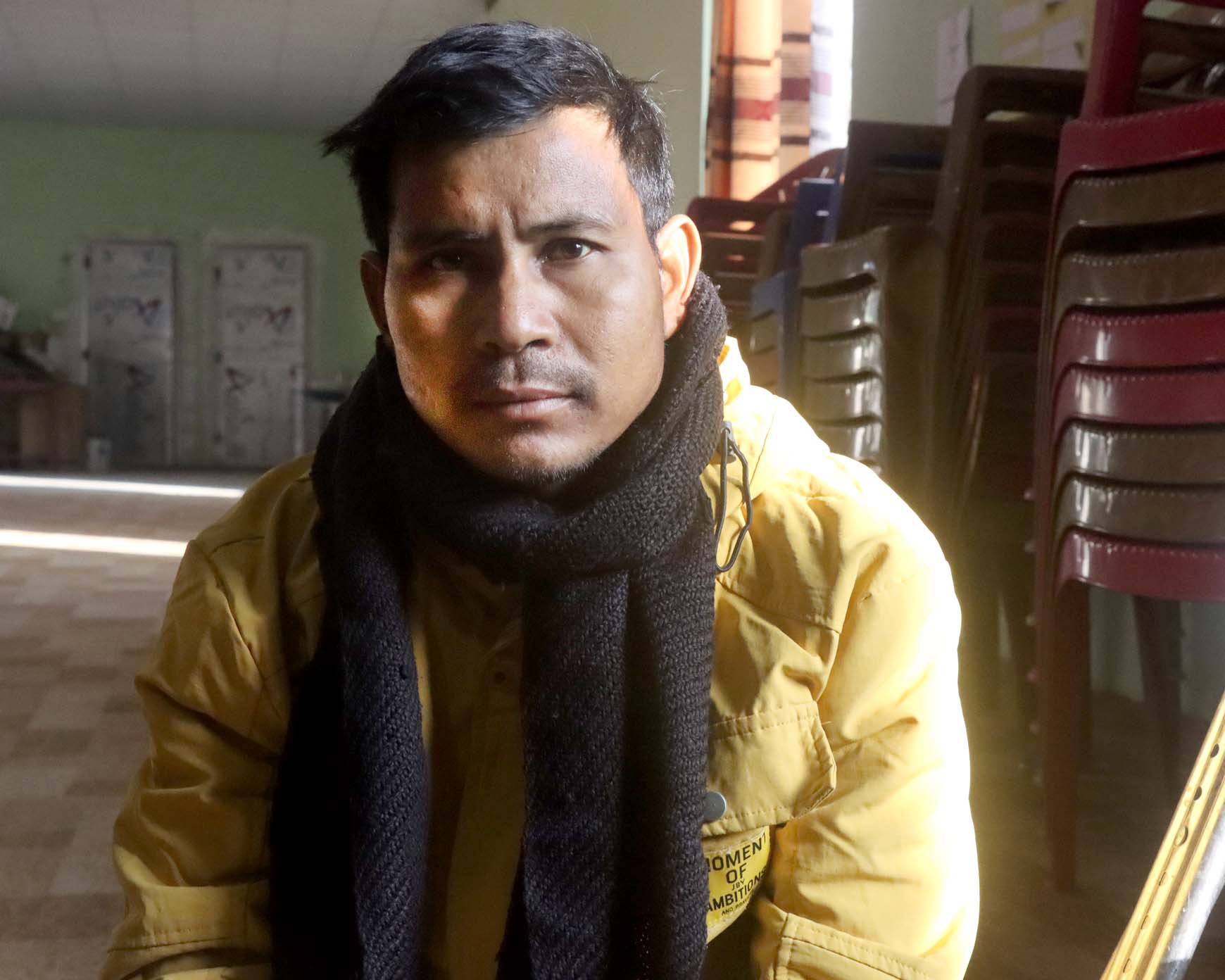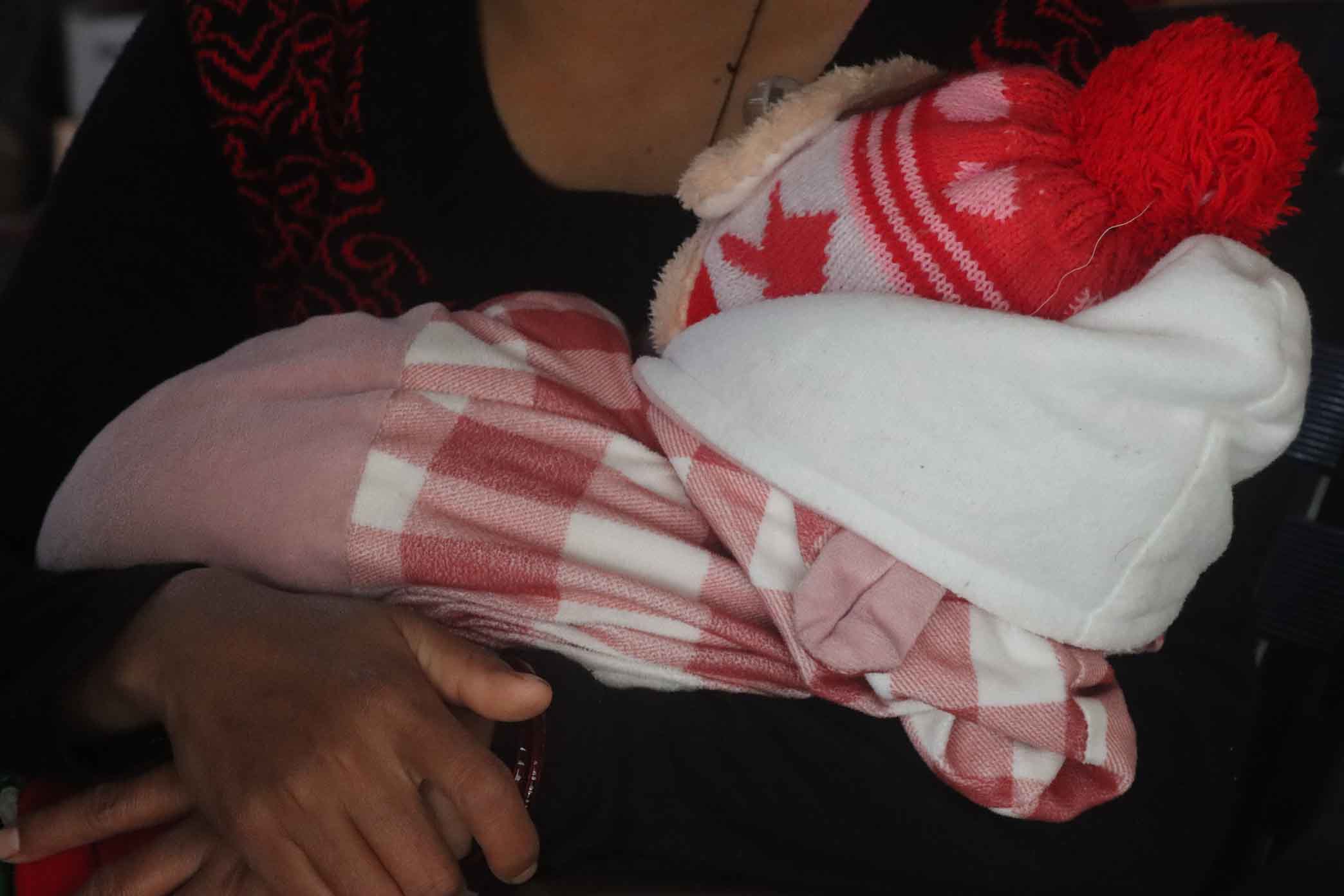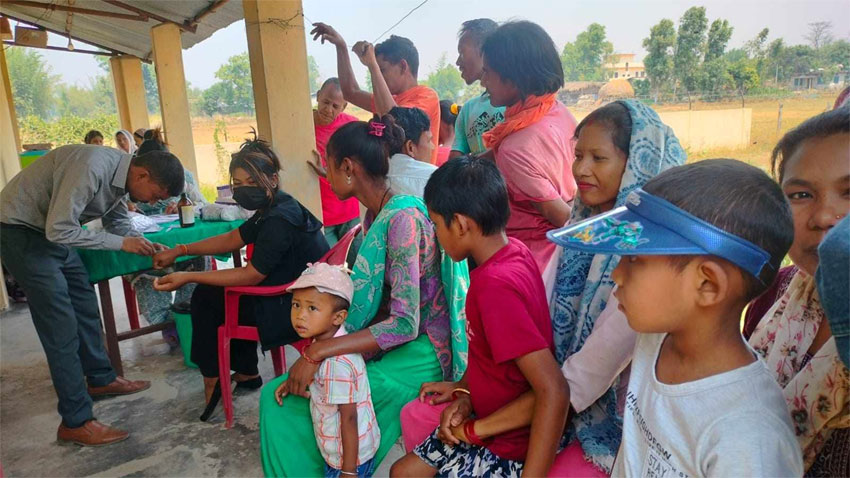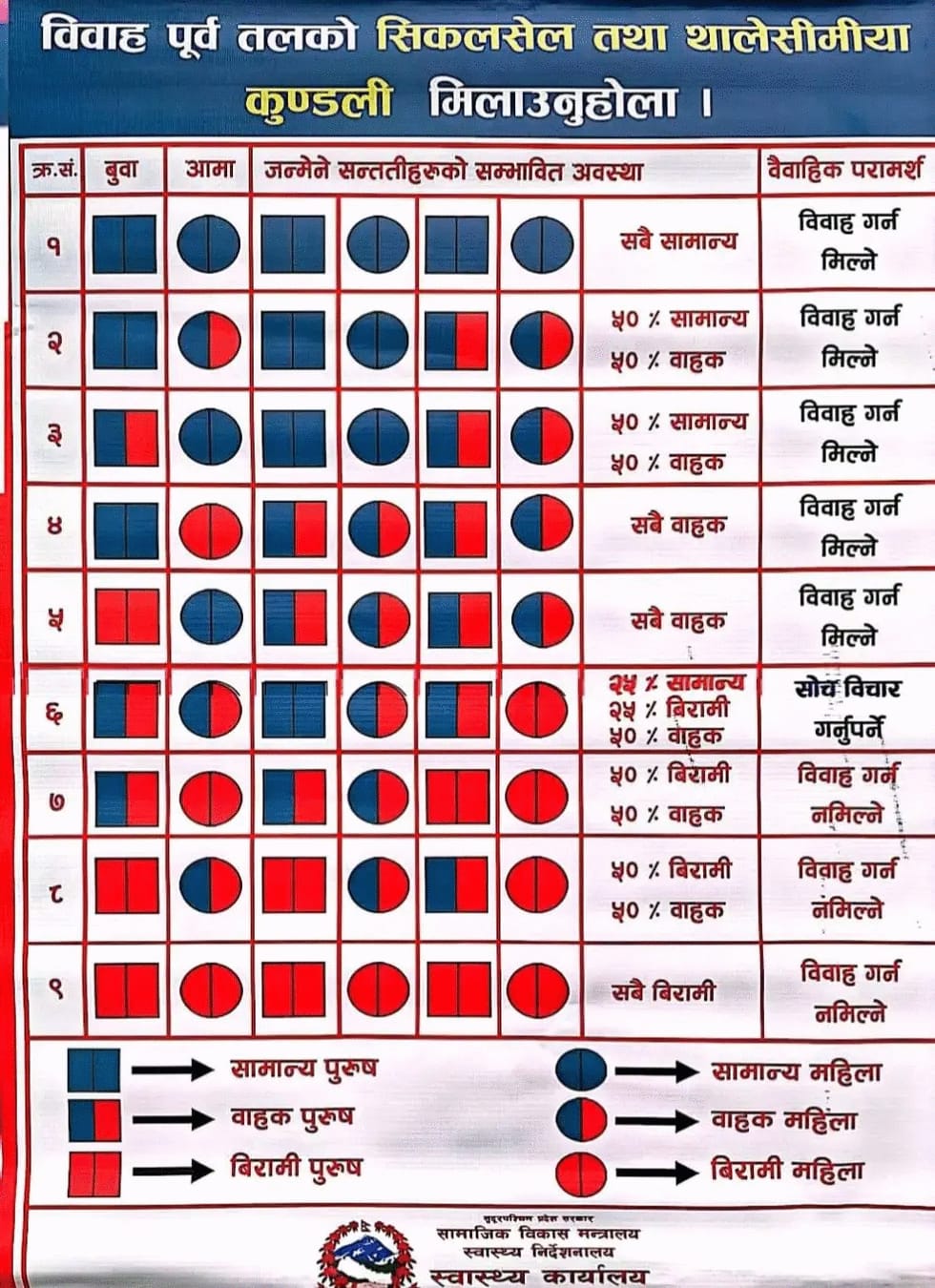While the number of sickle cell patients keeps on rising, the government appears indifferent to the disease’s impacts. As the young labour force falls sick, the state stands to lose a lot.
Unnati Chudhary | CIJ Nepal

Sickle cell disease patient, Sanghuram Chaudhary. Photos: Unnati Chaudhary.
In front of the rural municipality office, Sanghuram Chaudhary was barely standing with the help of crutches. One could see infinite pain lined up in his face. It has been nine years since the sickle cell disease has gripped Sanghuram, who is 38 and hails from Loharpur in Kailari Rural Municipality-8. After blood circulation to his leg stopped gradually, doctors removed it in Mangsir. Meanwhile, Chaudhary grapples with constant physical pain and problems in various organs. He often has to have blood injected inside his body. It is for this reason he had reached the rural municipality office—to find out information regarding the facilities provided to sickle cell patients.
Sanghuram says that he lost all his property during the treatment. He had to sell his 2 kattha land and cattle to pay back a loan he took from a microfinance. He has a wife and an 11-year-old son. “Now even my friends who donated blood to me are drifting away from me,” he said.
Meanwhile, Nekiram Kathariya of Kailari-5 lost two of his children aged 16 and 14 to an undisclosed disease. “My daughter would suffer from fever, and when she also got diarrhea once or twice, we couldn’t save her,” Kathariya said. “My son had a stone in his kidney and also jaundice.”
Kathariya’s wife is also a sickle cell patient. Later on, their eldest daughter also had the disease. Kathariya guesses that the reason for his children’s death is sickle cell disease. Doctors say that sickle cell patients tend to have conditions such as kidney stones and jaundice.
From her childhood, Sushma Rana Tharu, a 29-year-old from Dhangadhi, suffered from conditions such as constant fatigue, and she felt pain in her hands, legs and body. After she began to fall sick every month, her parents consulted dhami-jhankri (traditional healers). Her brother Shivam also showed the same problems; both turned out to be suffering from sickle cell disease.
Now Shivam’s five-year-old son has also shown the same symptoms. This time around, however, they consulted a doctor first, not dhami-jhankri. “All three of us are having medicines,” Sushma says.
Excessive pain, haphazard management
Prof. Dr. Bishesh Paudel says that sickle cell disease gives a lot of pain and its treatment is expensive. Though the government has made some help in treatment of sickle cell patients, that, however, hasn’t contributed to much, Paudel says. “Patients of this disease may feel a constant pain that is more intense than what women in labour feel,” he says.

Sanghuram Chaudhary, who lost his leg from sickle cell disease, and his wife.
The blood cells of sickle patients look like a sickle, and when they are entangled, that harms blood circulation and gives immense pain, Paudel says. Because of obstacles in blood circulation, many body organs stop working and even lead to a heart attack.
This hereditary disease is more prevalent among Tharu communities in west Nepal, especially in Kanchanpur, Kailali, Bardiya, Banke and Dang districts.
According to a research conducted in Dang by Santaram Chaudhary two years ago, 9.3 percent of Tharu people had sickle cell disease. Researchers presume that the number of those affected by the disease is less in Dang. According to a study conducted by Health Office Bardiya on 1992 people, 11 percent were found to have sickle cell disease.
According to the Nepal Health Research Council, except for these small-scale surveys and studies, there hasn’t been a detailed study on the prevalence of sickle cell disease in Nepal. The council’s report on the study about sickle cell in Tarai districts is yet to be out, says Chandrabhusan Yadav, information officer at NHRC.
“The only way that can cure the disease so far is to give gene therapy to those over 12 years of age but that is very expensive,” Dr. Paudel says. “Gene therapy costs around Rs. 160-170 million abroad.” Meanwhile, bone marrow transplant can cure the disease among those below five years of age, he added. Even though Nepal has enough resources to conduct bone marrow transplant, the government hasn’t managed them properly, Paudel complains.
The federal government provides a total of Rs 100,000 to patients suffering from sickle cell disease for their treatment.
Women bear the brunt
Sickle cell disease has turned the life of Radha Chaudhary, from Godawari Municipality-8, really difficult. Her elder brother and sister and a younger brother all suffer from the same disease.

Sickle cell disease patient Radha Chaudhary with her child.
Radha, who is 35, says that she had sickle cell positive nine years ago while she was at her maternal home in Krishnapur-6, Kanchanpur nine years ago, and she was the first person to have the disease confirmed in her entire village. “It was from about that time that the Seti Hospital began to keep statistics on sickle cell disease,” she says.
Her marriage with her boyfriend Rajesh Chaudhary was fixed in 2073 BS when she was studying for a bachelor’s degree. But she fell sick just before marriage. When her boyfriend’s family knew she had sickle cell disease, they didn’t want to marry her into their family. She was married only after three years on the condition that her maternal family would bear the contingent treatment cost.
Radha conceived a child in 2079 BS. After blood began to appear in her urine, she visited many hospitals. When she fell seriously ill, she was admitted to Blood Hospital in Kathmandu.
“I had to stay at ICU for 12 days,” she says. “I had to be given 17 pints of blood.” According to the doctor’s advice, she stayed in Kathmandu until her delivery. Sickle cell disease causes her spleen to swell often. “There’s no bound to pain,” she says. “I even have difficulty breathing, sitting and standing.”
Doctors have suggested her spleen be taken out through surgery. She also knows that bone marrow transplant would help control her disease to a large extent. But she can’t afford the Rs5-7 lakhs that is required for the transplant.
Samjhana Chaudhary, a 17-year-old from Kanchanpur, faces constant body pain due to sickle cell disease. A year ago, when she went to the hospital after falling ill, the blood in her body had already dwindled a lot. Upon check-up at Seti Provincial Hospital, it turned out that she had sickle cell disease. “Much money was spent on treatment. I am regularly using medicine,” she says. “This constant pain makes me feel like I’d die soon.”
When 35-year-old Sangita Chaudhary, from Kailari-8, falls sick, she doesn’t even have anyone to help her at the hospital. Because she has sickle cell disease, the joints in her hands and legs are weak and she can’t walk properly. She is given four pints of blood monthly. Because of her poor economic status, she hasn’t gotten proper treatment.
It is her maternal family who are assisting her in times of need, including managing funds and helping her when she’s sick. In 9 years, she has spent Rs. 700,000 in treatment, she says. “After I was found to have the disease, my neighbours began to ostracise me,” she says.
Sickle cell disease is a taboo in communities with low awareness levels. The disease becomes a reason for someone not getting married. Even if someone with the disease gets married, they are ostracised and discriminated against.
Sangita’s two children also suffer from sickle cell disease. But she hasn’t told this to anyone fearing she’d be further ostracised. “There’s a wrong concept about sickle cell disease in the village,” she says. “They say the patients should be driven away from the village. They treat us like untouchables.”
Radha Chaudhary’s friends also had sickle cell. This is why the friend’s expected marriage was called off. The patient is now undergoing treatment in Kathmandu.
“Sickle cell disease brings hopelessness in life,” Radha says. “We can’t be as active as healthy people but society pressures us to do as much work. Women who have this disease face double discrimination.”
Researcher Yujin Kushmi says that even though sickle cell disease affects males and females in similar ways, women need special care during pregnancy and afterwards.
Because women have to do household chores like doing dishes and washing clothes and those in agriculture work have to be in contact with water, the disease further troubles them.
Yujin, who did his master’s thesis on this subject, claims that some patients have killed themselves after finding it difficult to cope up with societal and familial discrimination.
Dr. Paudel says that even though sickle cell disease affects males and females in the same ways, pregnant and postpartum women need special care.
Government’s indifference
After the country adopted federalism, the Sudurpaschim Province government released a directive for economic assistance for health treatment in 2077 BS. The Article 2 ( c ) of the directive’s first amendment includes sickle cell anemia disease, along with diseases related to heart and kidney, Parkinson’s disease, Alzheimer’s disease, spinal injury and head injury as hard diseases.

Residents testing for sickle cell disease at Kailali Health Post.
According to that directive, Radha Chaudhary of Godawari Municipality received Rs. 50,000 treatment cost from the ministry in 2078 BS. She says that then, sickle cell patients had received anywhere between Rs. 10,000 and Rs. 100,000 as treatment cost. But in 2079 BS, the provincial government didn’t provide any treatment cost to sickle cell patients.
In 2080 BS, the provincial government prepared a methodology to provide financial assistance to patients suffering from hard diseases. The methodology mentions cancer, kidney transplant, liver transplant, bone marrow transplant, spinal injury, brain haemorrhage, paralysis and neurological diseases as hard diseases. There’s no mention of sickle cell disease.
According to Pitambar Chaudhary, who is an activist against sickle cell disease, the Sudurpaschim provincial government has been spending millions in the name of sickle cell disease but there’s no programme aimed at patients. “The government is spending money on seminars, assemblies and identifying the patients while the real patients are suffering in want of treatment,” he said.
The Sudurpaschim government’s social development ministry has spent Rs. 45 million for ‘sickle cell management’ but it has no record of where that money has gone and under what heading.
Dr. Paudel, who works at Civil Service Hospital in Kathmandu, says that as many as 10 people visit the hospital on average daily these days. “Even though the government has said it has managed treatment facilities at places where the number of sickle cell patients is high, patients are still compelled to visit Kathmandu for treatment,” Dr. Paudel said.

Dr. Paudel said that just injecting blood into the patient’s body without ascertaining their condition can backfire. There needs to be extra care given to sickle cell patients, depending upon the conditions of their organs, he said. If the government wants, it can send expert doctors to the sickle cell affected areas, Dr. Paudel added.
If, among the two types of haemoglobin in the human body, one is sickle-shaped and another is of regular shape, then that is called sickle cell trait. But if both the haemoglobins are sickle-shaped, then that is called sickle cell disease.
Children of couples with sickle cell trait are 25 percent likely to have sickle cell disease, while those of couples with sickle cell disease are 100 percent likely to have the disease. Hence, doctors say that couples with sickle cell disease should avoid conceiving children altogether.
“While suggesting couples to not conceive a child might be beyond the ambit of doctors, in a mismanaged and haphazard health system like ours, and given the economic conditions of many sickle cell patients, the suggestion is valid,” Dr. Paudel said.



